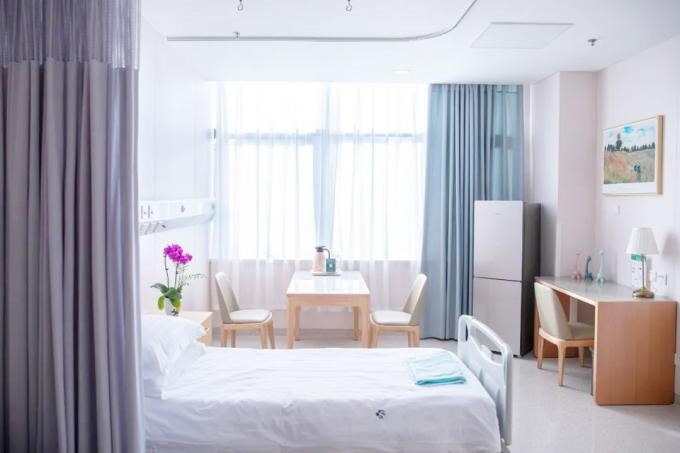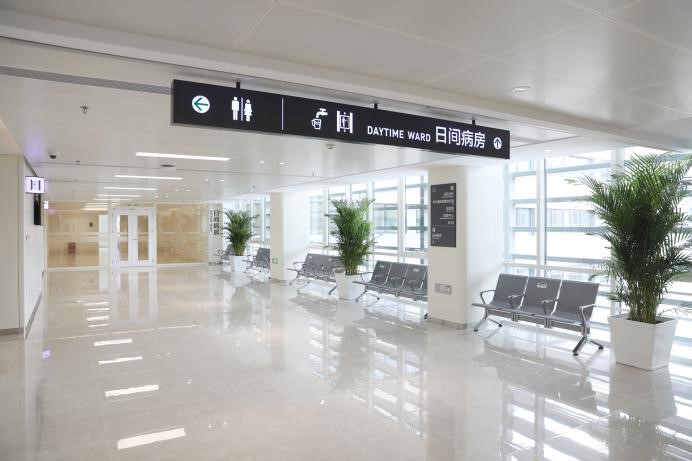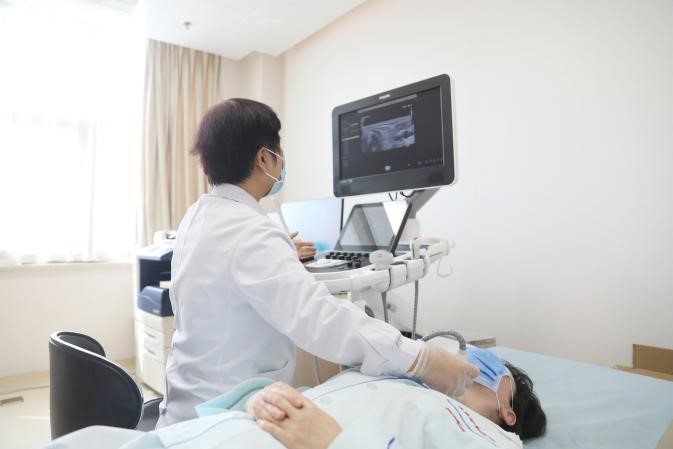Since the 18th CPC National Congress, PUMCH has focused on the core areas of medical services, and boldly explored and innovated to overcome more difficulties. For three years in a row, PUMCH has ranked first nationwide in CMI (case mix index), an indicator of the level of the overall technical difficulty in medical service provision, and was approved as a National Medical Center (general) and a pilot for high-quality development of public hospitals, securing leapfrog development and historic accomplishments.
Continue to Improve Abilities in Diagnosing and Treating Intractable and Rare Diseases
Firmly anchored in its functional positioning as the national guiding center for intractable diseases, PUMCH has over the past ten years been an internationally leading institution in the diagnosis and treatment of pancreatic cancer and in deepening and expanding multidisciplinary collaboration, taken a leap forward in rare diseases, and adopted a stream of new technological applications, continuing to lead China’s medical development.
“Acute, critical, severe, complicated, difficult and rare diseases” are like Mount Everest that PUMCHers aspire to climb. On January 27, 2021, the robotic spleen-preserving distal pancreatectomy (the Kimura technique) with preservation of splenic vessels performed by Academician Zhao Yupei, Honorary President, was successfully completed, which is the 1,000th robotic surgery in PUMCH and the 325th robotic pancreatic surgery performed by the team of Academician Zhao Yupei.
Minimally invasive technology and organ transplantation are the trend of surgery in the 21st century, and pancreatic surgery is the most complicated among laparoscopic surgeries. The Department of General Surgery, PUMCH has been working hard to surmount difficulties. As a result, they performed the first da Vinci robotic surgery in 2012 and have now completed more than 700 robotic pancreatic surgeries, covering almost all tumors that pancreatic surgeons could possibly run into. With up to 90% of the surgeries being minimally invasive, the Department of General Surgery has established itself as an internationally first-class player in minimally invasive surgery innovation and diagnosis and treatment of intractable diseases.
MDT is another “sharp weapon” that helps PUMCH confront intractable diseases squarely. In 2010, the hospital set up an outpatient consultation center for intractable diseases, which marked the transition “from doctor-centered to patient-centered”. Over the past 12 years since then, the hospital has opened 34 specialized teams for pancreatic tumors, pituitary tumors, tumors of the lateral skull base, metabolic bone diseases and rare diseases, etc., treating nearly 12,000 patients with intractable and rare diseases.
On October 31, 2019, dozens of members of the PUMCH rare disease team and external experts discussed the way to inject the specific drug nusinersen for two adult patients with spinal muscular atrophy (SMA). Over the course since the onset more than 25 years ago, the patient has suffered from severe and complex scoliosis; in light of this, PUMCH innovatively adopted the harmless ultrasound-guided intrathecal injection to great success, further advancing the intrathecal injection technique for SMA patients.
Since the 18th CPC National Congress, China has secured a series of groundbreaking accomplishments concerning rare diseases. In 2018, five ministries and commissions jointly released “China’s First List of Rare Diseases”, a document of landmark significance. In 2019, the National Health Commission established the National Rare Disease Diagnosis and Treatment Collaborative Network, thereby basically forming a three-tiered prevention and control system for rare diseases, in which PUMCH acts as the only national-level leading hospital. PUMCH took the lead in writing “Compendium of China’s First List of Rare Diseases”, “Rare Disease Diagnosis and Treatment Guide” and “Textbook on Rare Disease”. The hospital established the National Rare Diseases Registry System (NRDRS) and formed a national collaborative research team that consists of professionals specialized in multiple diseases. Positive developments have been seen in medical insurance coverage as well, for example multiple drugs for rare diseases, such as mitotane, laronidase, tafamidis, icatibant, broselumab, iptacopan and clobazam, have first been used in PUMCH. The list goes on. They all show that the government doesn’t neglect any group of people.
On top of that, AI is rapidly emerging and flourishing in various medical fields. The AI-aided recognition tool for generalized pustular psoriasis (GPP) has been launched and it can increase the recognition accuracy of GPP to over 85%. The “multimodal and smart neurological disease diagnosis system” developed by the Department of Neurology, PUMCH in conjunction with the Institute of Software, Chinese Academy of Sciences will be available soon. The Department of Plastic Surgery and Tsinghua University are studying the use of facial 3D recognition technology to diagnose rare genetic diseases. And the list goes on, showing that PUMCHers are relentless in their pursuit of new technology application and translations.
Speed up Efforts to Address “Difficult Access to Medical Services” for People
The ultimate goal of medical service provision is to continuously protect people’s health, a necessary precondition of their expectation for a beautiful life. Ten years ago, the daily outpatient visits of PUMCH approached 10,000; the hospital was overloaded by the excessively long queues of patients, a rather unusual scene in Dongdan, where the hospital is seated. Today, the daily outpatient visits reach 17,000 at the peak, and it takes patients only 3 to 5 minutes to pay bills or pick up their medications, making the long queues a thing of the past. This transformation is attributable to PUMCH’s pioneering efforts in appointment making, patient service, quality care, environmental improvement, medical-wellness integration, and Internet hospital to improve quality and efficiency of medical services on all dimensions.
—Vigorously promoted easy access to medical services. Over the past ten years, PUMCH has launched a variety of appointment-making channels such as the PUMCH app, the in-hospital self-service machines and bank ATMs, which enable patients to enjoy more than 60 services such as smart navigation, self-service appointment-making for examinations and tests, and self-service bill payment by just tapping the screens according to the instructions. The upcoming WeChat-enabled smart services will greatly shorten the time needed for patients to seek medical care.
—Optimized medical service process. The hospital has launched an outpatient referral system, which enables “patient-to-physician” and “patient-to-department” referrals for patients with intractable diseases; referral posts have also been set up in each department. Forty-seven departments and a thousand physicians have participated in the system, and a total of more than 79,000 referral applications have been initiated.
—Smoother doctor-patient communications. The hospital has set up a patient service center to actively promote block scheduling, one-stop appointment-making, convenient billing and medical insurance reimbursement in one, and mutual recognition of test results. The hospital has set up a taskforce to receive and handle complaints, and the response rate, resolution rate and satisfaction rate all reached 100% in the performance review for rapid handling of complaints in July 2022, as announced by the 12345 government service hotline.
—Significantly improved hospital environment. In 2012, the new outpatient and emergency building in Dongdan Campus of PUMCH was opened, encompassing all outpatient service functions in one building, and making it more convenient for patients with automatic packaged pill dispenser, pneumatic transmission system, and paperless consultation; in 2021, the outpatient building in Xidan Campus of PUMCH was opened, with such impressive innovations as the one-stop diagnosis and treatment by specialty, the day medical center, and one-stop general appointment-making. PUMCH has been expanding the portfolio of services on offer, including international medical services and health management, in a bid to provide people with diverse and compassionate quality services up to international standards.
—Significant accomplishments in quality nursing. Accountability-based and patient-centered holistic nursing has expanded from PUMCH to the whole country. 2012 saw the 100% coverage of quality nursing. PUMCH gives full play to its characteristic specialized nursing and has cultivated nearly 600 specialized nursing talents in 30-odd specialties. It continues to drive the development of nursing in China.
—Innovative model of integrating medical care and elderly care. PUMCH adopts a modern geriatric medicine model and has innovatively put in place integrated outpatient clinic, joint ward rounds, and the combination of medical care and elderly care; it advocates hospice and palliative care to take good care of patients till their last moment. PUMCH aspires to provide all-round and continuous medical services for the elderly patients.
—Thriving internet diagnosis and treatment. PUMCH is the first Internet hospital in Beijing, and more than 1,300 of its doctors in 41 specialties offer online services, benefiting patients with online consultation, diagnosis and treatment and home delivery of drugs. PUMCH works with more than 300 medical institutions in 31 provinces across China to provide telemedicine.
Despite the havoc wreaked by COVID-19, PUMCH holds firm to the general policy of “Dynamic Zero”. The hospital has established an emergency command system for epidemic prevention and control and adjusted the prevention and control measures according to the situation, thereby achieving the overarching goal of “zero nosocomial infection and no shutdown”. Confronted with difficulties and challenges that never cease to pop up, it always tries every means possible to help people get medical services; for example, it devises a tailored plan for each patient who is in acute, critical and severe conditions, pregnant or in labor, suffers from cancer, or on dialysis; for patients in need of follow-up visits but couldn’t get to the hospital, PUMCH offers online services. Such examples abound and they all speak volumes about PUMCH’s commitment to “people first, life first”.
Stimulate Endogenous Driving Force and Play a Leading Role
Since the 18th CPC National Congress, healthcare has been on the fast track of high-quality development. Benchmarking itself against internationally first-class disciplines, PUMCH has made continuous efforts around core competitiveness of disciplines and technological innovation, thereby increasing the influence and reach of its services for people continuously.
Working hard on discipline construction is of fundamental importance to high-quality development. In 2022, PUMCH has organized 14 seminars on high-quality development and held 11 assessments of high-quality development of disciplines in 6 batches consecutively, soliciting advice with an open mind and promoting development with assessments to identify the focus of high-quality development. A hundred medical experts offered their opinions and suggestions and also frankly pointed out the shortcomings and deficiencies, which were all embraced by the 54 disciplines and informed the formulation or improvement of the high-quality development plan of their own discipline.
PUMCHers aspire to shoulder more responsibilities for promoting standardization in healthcare, living up to the expectations of the country and the people.
—Strengthening the medical consortium and specialty alliance, and promoting the expansion of high-quality medical resources to the primary level. PUMCH has established a medical consortium with Dongcheng District, Beijing, in which the tiered model built by 28 specialties and featuring “first visit to primary care providers, two-way referrals, separate handling of acute and chronic conditions, and interaction across hierarchies” has been performing well. Multiple specialties have established a specialty consortium and specialty alliance with a nationwide reach, tasked with telemedicine, scientific research, personnel training and technology promotion as well as promoting standardization in primary care.
—Relying on specialty quality control centers to play a leading and demonstrative role in the industry. The hospital has 17 national- and municipal-level specialty quality control centers. By building a national quality control network, establishing an organizational system and working mechanism at the four levels of organizational management, standardized diagnosis and treatment, quality control and continuous improvement, formulating industry guidelines and standards, PUMCH plays a leading and demonstrative role in various specialties and helps improve primary care in all aspects.
As the next 100 years unfold, PUMCH is at a new starting point. Setting sight on building itself as a National Medical Center and a pilot of high-quality development for public hospitals according to requirements, PUMCH will embark on the new journey with greater gusto and initiative, strive to deliver outstanding performance in high-quality development and play its role in spearheading the development of healthcare in China.




Significant changes to the hospital over the past decade provide patients with better experience
Written by: Chen Mingyan
Translator: Liu Haiyan
Editor: Wang Yao
